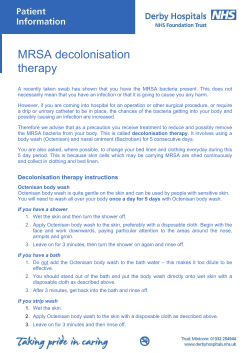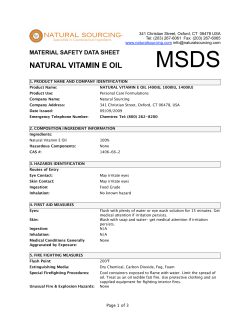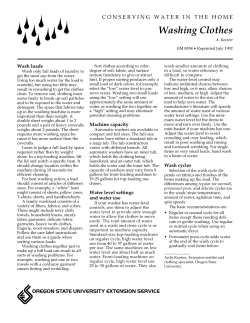
Document 173020
A HACCP Flowchart for Beef Stew Critical Control Hazard Standards Corrective Action if Standard is not Met Receiving Receiving Beef Receiving Vegetables Critical Control Contamination and spoilage Contamination and spoilage Hazard Accept beef at 45˚F or lower; verify with a thermometer Reject delivery Packaging intact Reject delivery No off odor or stickiness, etc. Reject delivery Packaging intact Reject delivery No cross-contamination from other foods on the truck. Reject delivery No signs of insect or rodent activity Reject delivery Standards Corrective Action if Standard is not Met Storage Storing Raw Beef Storing Vegetables Critical Control Cross-contamination of other foods Store on lower shelf Move to lower shelf away from other foods. Label, date and use "First-in-firstout" rotation Use first, discard if maximum time is exceeded or suspected Bacterial Growth and spoilage Beef temperature must remain below 41˚F Discard if time and temperature are abused Bacterial Growth and spoilage Label, date and use "First-in-firstout" rotation Discard product held past rotation date Cross-contamination from raw potentially hazardous foods Keep above raw potentially hazardous foods Discard contamination, damaged or spoiled products Standards Corrective Action if Standard is not Met Hazard Preparation Trimming and cubing beef Washing and cutting vegetables Cross-contamination and bacteria increase Contamination and cross-contamination Wash hands Wash hands Clean and sanitize utensils Wash, rinse and sanitize utensils and cutting board Pull and cube one roast at a time, then refrigerate Return excess amount to the refrigerator Wash hands Wash hands Use clean and sanitized cutting board, knives and utensils Wash, rinse and sanitize utensils and cutting board Wash vegetables in clean and sanitized vegetable sink Clean and sanitize vegetable sink before washing vegetables Source: Applied FoodService Sanitation 4th Ed. Pg 82-84. Critical Control Hazard Standards Corrective Action if Standard is not Met Cooking Bacterial Survival Physical contamination during cooking Cooking Stew Contamination by herbs and spices Contamination of utensils Contamination from cooks hand or mouth Critical Control Hazard Cook all ingredients to minimum internal temperature of 165˚F Continue cooking to 165˚F Verify final temperature with a thermometer Continue cooking to 165˚F Keep covered, stir often Cover Add spices early during cooking procedure Measure all spices, flavor enhancers and additives, and read labels carefully. Continue cooking at least 1/2 hour after spices are added Use clean and sanitized utensils Wash, rinse and sanitize serving utensils before use Use proper tasting procedures Discard product Standards Corrective Action if Standard is not Met Holding and Service Use clean and sanitary equipment to transfer and hold product. Hot Holding and serving Contamination, bacterial growth Wash, rinse and sanitize equipment before transferring food product to it Hold stew above 135˚F in preheated holding unit, stir to maintain even temperature Keep covered Clean and sanitize serving equipment and utensils Return to stove and reheat to 165˚F Cover Wash, rinse and sanitize serving equipment and utensils Source: Applied FoodService Sanitation 4th Ed. Pg 82-84. Critical Control Hazard Standards Corrective Action if Standard is not Met Cooling Bacterial survival and growth Cooling for storage Cool rapidly in ice water bath and / or shallow pans (<4" deep) Move to shallow pans Cool rapidly from 135˚F to 41˚F in less than 4 hours Discard, or reheat to 165˚F and re-cool one time only Verify final temperature with a thermometer; record temperatures and times before product reaches 41˚F or less If temperature is not reached in less than four hours, discard; or reheat product to 165˚F and re-cool one time only. Place on top shelf Move to top shelf Cover immediately after cooling Cover Use clean and sanitized pans Wash, rinse and sanitize pans before filling them with product Do not stack pans Separate pans by shelves Label with date and time Label with date and time or discard Standards Corrective Action if Standard is not Met Cross-contamination Bacterial growth in time or after prolonged storage time Critical Control Hazard Reheating Reheat for service Survival of bacterial contaminants Heat rapidly on stove top or in oven to 165˚F Reheat to 165˚F within 2 hours Maintain temperature at 135˚F or above; verify temperature with a thermometer. Transfer to preheated hot holding unit to maintain 135˚F or above. Do not mix new product into old product Discard product Do not reheat or serve leftovers more than once Discard product if any remains after being reheated Source: Applied FoodService Sanitation 4th Ed. Pg 82-84.
© Copyright 2025

















